《基础工程》课程PPT教学课件(英文讲稿)Chapter 07 Mat Foundation

Chapter 7 Mat Foundation
Chapter 7 Mat Foundation
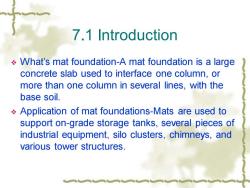
7.1 Introduction What's mat foundation-A mat foundation is a large concrete slab used to interface one column,or more than one column in several lines,with the base soil. Application of mat foundations-Mats are used to support on-grade storage tanks,several pieces of industrial equipment,silo clusters,chimneys,and various tower structures
7.1 Introduction ❖ What’s mat foundation-A mat foundation is a large concrete slab used to interface one column, or more than one column in several lines, with the base soil. ❖ Application of mat foundations-Mats are used to support on-grade storage tanks, several pieces of industrial equipment, silo clusters, chimneys, and various tower structures

7.1 Introduction Suitable conditions of mat foundation -Where the base soil has a low beating capacity and/or the column loads are so large that more than 50 percent of the area is covered by conventional spread footings. -For deep basements. -where the settlements may be a problem. Advantages of mat foundation -there is a stress compensation from excavated soil so that the net increase in pressure is controlled. -provide a water barrier when basements at or below the GWT
7.1 Introduction ❖ Suitable conditions of mat foundation ❖ -Where the base soil has a low beating capacity and/or the column loads are so large that more than 50 percent of the area is covered by conventional spread footings. ❖ -For deep basements. ❖ -where the settlements may be a problem. ❖ Advantages of mat foundation ❖ - there is a stress compensation from excavated soil so that the net increase in pressure is controlled. ❖ -provide a water barrier when basements at or below the GWT

7.2 Types of Mat Foundations -flat plate -plate thickened under columns -waffleslab (beam and slab) -plate with pedestals -basement walls as part of mat
7.2 Types of Mat Foundations ❖ -flat plate ❖ -plate thickened under columns ❖ -waffleslab (beam and slab) ❖ -plate with pedestals ❖ -basement walls as part of mat
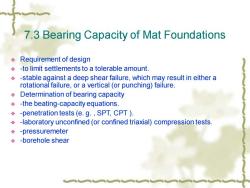
7.3 Bearing Capacity of Mat Foundations Requirement of design -to limit settlements to a tolerable amount. -stable against a deep shear failure,which may result in either a rotational failure,or a vertical(or punching)failure. Determination of bearing capacity -the beating-capacity equations. -penetration tests(e.g.,SPT,CPT). -laboratory unconfined(or confined triaxial)compression tests. -pressuremeter -borehole shear
7.3 Bearing Capacity of Mat Foundations ❖ Requirement of design ❖ -to limit settlements to a tolerable amount. ❖ -stable against a deep shear failure, which may result in either a rotational failure, or a vertical (or punching) failure. ❖ Determination of bearing capacity ❖ -the beating-capacity equations. ❖ -penetration tests (e. g. , SPT, CPT ). ❖ -laboratory unconfined (or confined triaxial) compression tests. ❖ -pressuremeter ❖ -borehole shear
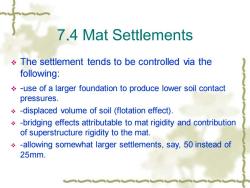
7.4 Mat Settlements The settlement tends to be controlled via the following: -use of a larger foundation to produce lower soil contact pressures. -displaced volume of soil (flotation effect). -bridging effects attributable to mat rigidity and contribution of superstructure rigidity to the mat. -allowing somewhat larger settlements,say,50 instead of 25mm
7.4 Mat Settlements ❖ The settlement tends to be controlled via the following: ❖ -use of a larger foundation to produce lower soil contact pressures. ❖ -displaced volume of soil (flotation effect). ❖ -bridging effects attributable to mat rigidity and contribution of superstructure rigidity to the mat. ❖ -allowing somewhat larger settlements, say, 50 instead of 25mm
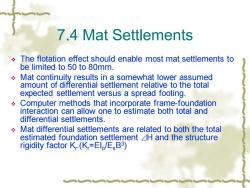
7.4 Mat Settlements The flotation effect should enable most mat settlements to be limited to 50 to 80mm. Mat continuity results in a somewhat lower assumed amount of differential settlement relative to the total expected settlement versus a spread footing. Computer methods that incorporate frame-foundation interaction can allow one to estimate both total and differential settlements. Mat differential settlements are related to both the total estimated foundation settlement /H and the structure rigidity factor K(K,=El/EB3)
7.4 Mat Settlements ❖ The flotation effect should enable most mat settlements to be limited to 50 to 80mm. ❖ Mat continuity results in a somewhat lower assumed amount of differential settlement relative to the total expected settlement versus a spread footing. ❖ Computer methods that incorporate frame-foundation interaction can allow one to estimate both total and differential settlements. ❖ Mat differential settlements are related to both the total estimated foundation settlement ⊿H and the structure rigidity factor Kr .(Kr=EIb /EsB3 )
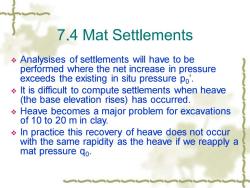
7.4 Mat Settlements Analysises of settlements will have to be performed where the net increase in pressure exceeds the existing in situ pressure po. It is difficult to compute settlements when heave (the base elevation rises)has occurred. Heave becomes a major problem for excavations of 10 to 20 m in clay. In practice this recovery of heave does not occur with the same rapidity as the heave if we reapply a mat pressure qo
7.4 Mat Settlements ❖ Analysises of settlements will have to be performed where the net increase in pressure exceeds the existing in situ pressure p0 ’. ❖ It is difficult to compute settlements when heave (the base elevation rises) has occurred. ❖ Heave becomes a major problem for excavations of 10 to 20 m in clay. ❖ In practice this recovery of heave does not occur with the same rapidity as the heave if we reapply a mat pressure q0
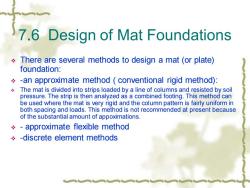
7.6 Design of Mat Foundations There are several methods to design a mat (or plate) foundation: -an approximate method conventional rigid method): The mat is divided into strips loaded by a line of columns and resisted by soil pressure.The strip is then analyzed as a combined footing.This method can be used where the mat is very rigid and the column pattern is fairly uniform in both spacing and loads.This method is not recommended at present because of the substantial amount of appoximations. -approximate flexible method -discrete element methods
7.6 Design of Mat Foundations ❖ There are several methods to design a mat (or plate) foundation: ❖ -an approximate method ( conventional rigid method): ❖ The mat is divided into strips loaded by a line of columns and resisted by soil pressure. The strip is then analyzed as a combined footing. This method can be used where the mat is very rigid and the column pattern is fairly uniform in both spacing and loads. This method is not recommended at present because of the substantial amount of appoximations. ❖ - approximate flexible method ❖ -discrete element methods

7.6.1 Approximate Flexible Method The approximate flexible method requires the following steps: -compute the plate rigidity -compute the radius of effective stiffness -compute the radial and tangential moments,the shear,the deflection using the following equations where load P acts:
7.6.1 Approximate Flexible Method ❖ The approximate flexible method requires the following steps: ❖ -compute the plate rigidity ❖ -compute the radius of effective stiffness ❖ -compute the radial and tangential moments, the shear, the deflection using the following equations where load P acts:
按次数下载不扣除下载券;
注册用户24小时内重复下载只扣除一次;
顺序:VIP每日次数-->可用次数-->下载券;
- 《基础工程》课程PPT教学课件(英文讲稿)Chapter 06 Special footings and beams on the elastic foundations.ppt
- 《基础工程》课程PPT教学课件(英文讲稿)Chapter 05 Spread footing design.ppt
- 《基础工程》课程PPT教学课件(英文讲稿)Chapter 04 Factors to consider in foundation design.ppt
- 《基础工程》课程PPT教学课件(英文讲稿)Chapter 03 Improving Site Soils for Foundation Use.ppt
- 《基础工程》课程PPT教学课件(英文讲稿)Chapter 02 基础承载力 Bearing capacity of foundation(2/2).ppt
- 《基础工程》课程PPT教学课件(英文讲稿)Chapter 02 基础承载力 Bearing capacity of foundation(1/2).ppt
- 《基础工程》课程PPT教学课件(英文讲稿)Chapter 02 Bearing capacity of foundations.ppt
- 《基础工程》课程PPT教学课件(英文讲稿)Chapter 10 Single Piles(2/2).ppt
- 《基础工程》课程PPT教学课件(英文讲稿)Chapter 10 Single Piles(1/2).ppt
- 《基础工程》课程PPT教学课件(英文讲稿)Chapter 01 Introduction.ppt
- 长沙理工大学:《基础工程》课程电子教案(PPT课件)绪论(主讲:赵明华).ppt
- 长沙理工大学:《基础工程》课程电子教案(PPT课件)第四章 桩基础.ppt
- 长沙理工大学:《基础工程》课程电子教案(PPT课件)第六章 基坑工程.ppt
- 长沙理工大学:《基础工程》课程电子教案(PPT课件)第八章 地基处理.ppt
- 长沙理工大学:《基础工程》课程电子教案(PPT课件)第五章 沉井基础.ppt
- 长沙理工大学:《基础工程》课程电子教案(PPT课件)第二章 刚性基础与扩展基础.ppt
- 长沙理工大学:《基础工程》课程电子教案(PPT课件)第三章 柱下条形基础、筏形和箱形基础.ppt
- 长沙理工大学:《基础工程》课程电子教案(PPT课件)第一章 地基基础设计原则.ppt
- 长沙理工大学:《基础工程》课程电子教案(PPT课件)第四章 桩基础的设计计算.ppt
- 长沙理工大学:《基础工程》课程电子教案(PPT课件)第六章 地基基础.ppt
- 《基础工程》课程PPT教学课件(英文讲稿)Chapter 08 Mechanically Stabilized Earth and Concrete Retaining Walls.ppt
- 《基础工程》课程PPT教学课件(英文讲稿)Chapter 09 Sheet-Pile Walls(Cantilevered and Anchored).ppt
- 《基础工程》课程教学资源(参考资料)中华人民共和国行业标准(JTG D61-2005)公路圬工桥涵设计规范.pdf
- 《基础工程》课程教学资源(参考资料)中华人民共和国行业标准(JTG D62-2004)公路钢筋混凝土及预应力混凝土桥涵设计规范 Code for Design of Highway Reinforced Concrete and Prestressed Concrete Bridges and Culverts.pdf
- 《基础工程》课程教学资源(参考资料)中华人民共和国行业标准(JTG D63-2007)公路桥涵地基及基础设计规范(报批初稿)Code for Design of Ground Base and Foundation of Highway Bridges and Culverts.pdf
- 同济大学:《有限元方法》课程教学资源(试卷习题)考核试卷(A卷)2011-2012学年第1学期(含解答).pdf
- 同济大学:《有限元方法》课程教学资源(试卷习题)WORKSHOP 10 SUPPORT BRACKET.pdf
- 同济大学:《有限元方法》课程教学资源(教案讲义)Chapter 1 Finite Element Method - Introduction to Finite Element Method.pdf
- 同济大学:《有限元方法》课程教学资源(教案讲义)Chapter 2 Stiffness Matrices, Spring and Bar Elements.pdf
- 同济大学:《有限元方法》课程教学资源(教案讲义)Chapter 3 Direct Stiffness Method(DSM).pdf
- 同济大学:《有限元方法》课程教学资源(教案讲义)Chapter 4 Flexure elements.pdf
- 同济大学:《有限元方法》课程教学资源(教案讲义)Chapter 6 Interpolation Functions for General Element Formulation.pdf
- 同济大学:《有限元方法》课程教学资源(教案讲义)Chapter 7 Isoparametric Element.pdf
- 同济大学:《有限元方法》课程教学资源(教案讲义)Chapter 8 Practical modeling Issues.pdf
- 北京化工大学:《过程设备设计》课程教学资源(课件讲稿)第四章 压力容器设计 Design of Pressure Vessels 4.3 常规设计 4.3.4 密封装置设计.pdf
- 上海海洋大学:工程学院2011年版课程教学大纲汇编(正文).pdf
- 上海海洋大学:食品学院2018年版课程教学大纲汇编(能源与动力、建筑环境专业).pdf
- 上海海洋大学:工程学院2018版课程教学大纲汇编(工业工程专业).pdf
- 上海海洋大学:工程学院2018版课程教学大纲汇编(其他).pdf
- 上海海洋大学:工程学院创新课程教学大纲合集(2022年版).pdf
